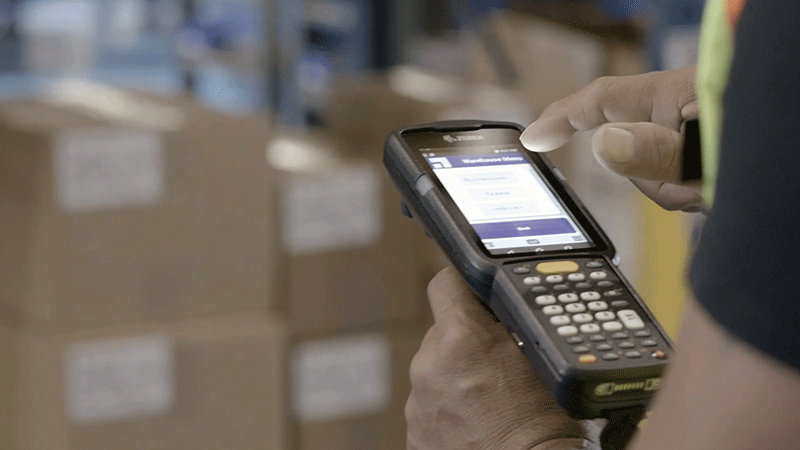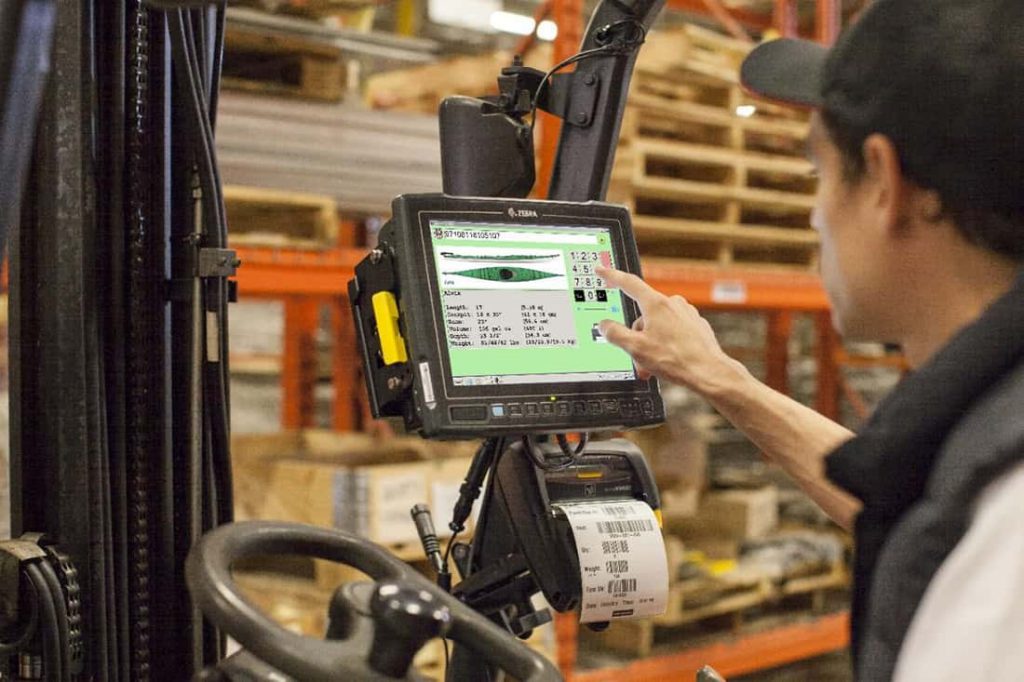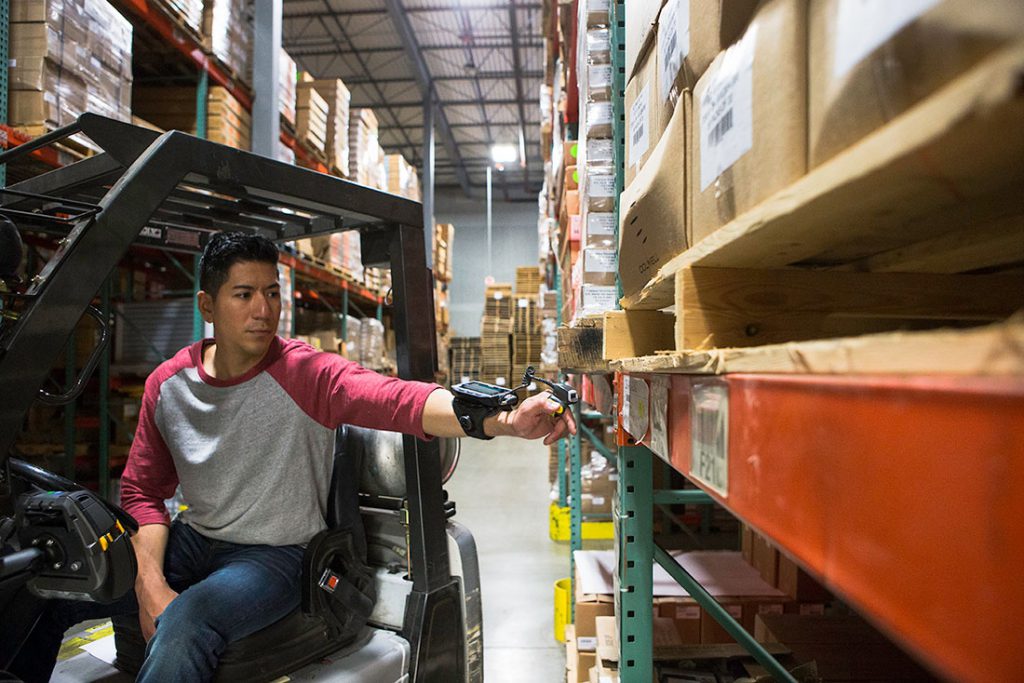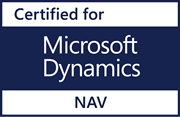Q&A Corner: Trends & Updates on Warehouse Data Collection Devices
Posted on December 7, 2021David Deardorff, Sales Engineer for Barcom, Inc., Lanham’s national hardware partner, was a speaker at our 2021 Lanham Supply Chain Intensive event. This post summarizes some of the key take-aways and Q&A from his presentation on warehouse data collection devices.
Q: What are some of the key trends in data collection hardware today?
Given the pandemic we’ve all been living through, one of the biggest trends in data collection devices today is Disinfectant-Ready Housing. Just as we experience cracked and dry skin thanks to frequent handwashing, the constant use of alcohol on devices’ plastic displays makes data collection devices brittle and easy to crack. Today, devices with Disinfectant-Ready Housing are able to withstand frequent exposure to manufacturer-recommended cleaning solutions, which minimizes the risk of the spread of germs and infectious diseases.
Flexible Range Scanning is another trend. The scan engines that allow you to simply pull the trigger and read barcodes have come a long way. Specifically, in the last 5-7 years the near–far range scan engines can read barcodes as close as 4 to 5 inches away, or as far as 30 feet away, and are becoming more standard and reliable. By reliable, I mean they can read the barcode at 5 inches away and then immediately read the barcode on a location 20-30 feet away. In the past, these near-far range scanners had a bit of a lag between registering the near and the far barcodes. Today this type of delay is barely noticeable, which is a welcome improvement.
Rugged Tablets & Mobile Devices are increasing productivity for vehicle operators. A lot of people ask us ‘why can’t I just buy an iPhone or Samsung Galaxy phone and just use that?’ And the answer is that you really need enterprise devices that are meant for warehouses. There are also Total Cost of Ownership (TCO) considerations that highlight the value of rugged enterprise devices for warehouses vs. consumer grade devices. At Barcom, we recommend industrial-grade solutions from industry leaders like Honeywell and Zebra. These rugged devices are designed to withstand bumps, drops, and spills in tough environments like manufacturing, distribution, and warehousing.
Q. How can companies eliminate gaps in wireless coverage in their warehouses?
When it comes to wireless coverage, conducting a site survey can help you evaluate gaps and create a more streamlined environment.
With Lanham’s ACE Warehousing solution, having a strong wireless infrastructure is critical. Roaming from one corner of the building to another corner of the building without any dropped data packets is key.
Barcom’s team is trained and educated on the Cisco gear and wireless infrastructure in general. We can come on-site and conduct a wireless survey, or we can do virtual surveys. The latter requires that you send us a dimensional floorplan of your facility, and we put it through a heat map and tell you what type of access points you need, and where to mount them. We can pre-configure them, so all you need to do is put them up in the rafters, flip on a switch, and you’re covered. Doing a site survey will address important coverage issues based on warehouse layout and other factors such as material fabrics which may absorb extra RF waves. It will also help you define your network security as well.
Q. How do I know which type of mobile terminal is best for my warehouse?
ACE Warehousing enables warehouse data collection devices in order to provide real-time inventory access, updates and status. These mobile devices, also referred to as “handhelds” or “mobile computers,” can be carried either in your hand or mounted on a vehicle.
 There are many considerations that go into deciding what type of handheld is best. We start by looking at your warehouse. Are you in a steel foundry, or are you storing carpets? Do you need to keep your warehouse cold to protect your inventory? The point is we have got to be sure the device can withstand your specific environment.
There are many considerations that go into deciding what type of handheld is best. We start by looking at your warehouse. Are you in a steel foundry, or are you storing carpets? Do you need to keep your warehouse cold to protect your inventory? The point is we have got to be sure the device can withstand your specific environment.
Another point to consider regarding mobile devices concerns the scan engines. Do you need to read barcodes from up close or from a distance, or a mix?
Determining the best device choice for your application will depend on the workflow processes and information being collected. A brief call with one of our solution experts can help you narrow down the right type of device for every aspect of your operations.
Other types of warehouse devices
Vehicle-mount devices —  are mounted on the vehicle in a fixed position. The device receives power from the vehicle’s battery, has a larger screen and keypad, and is totally hands-free. In this situation, you would either use a scanner that is connected via Bluetooth to the vehicle mount device, or that is connected via a tethered USB connection back to that device.
are mounted on the vehicle in a fixed position. The device receives power from the vehicle’s battery, has a larger screen and keypad, and is totally hands-free. In this situation, you would either use a scanner that is connected via Bluetooth to the vehicle mount device, or that is connected via a tethered USB connection back to that device.
Vehicle mount devices are about twice the cost of a mobile or handheld device, but if you have folks on lifts all day long, they will save you money in terms of the time and processes involved.
 Wearables — are terminals that wrap around your forearm and are fitted with a small ring scanner that sits on your finger to scan barcodes. Wearables can be used with either a tethered or a wireless USB connection. If you have a lot of small parts that need to be picked, and you need hands-free operations, these make sense and provide efficiencies. But, they’re not for everyone. For example, we had a customer that distributed liquor and had large boxes on the floor. When they were using the wearable devices, the warehouse workers couldn’t lift boxes from the underside when they had their ring scanners on. On the other hand, the wearable device was a perfect fit for another customer that had small parts for toys.
Wearables — are terminals that wrap around your forearm and are fitted with a small ring scanner that sits on your finger to scan barcodes. Wearables can be used with either a tethered or a wireless USB connection. If you have a lot of small parts that need to be picked, and you need hands-free operations, these make sense and provide efficiencies. But, they’re not for everyone. For example, we had a customer that distributed liquor and had large boxes on the floor. When they were using the wearable devices, the warehouse workers couldn’t lift boxes from the underside when they had their ring scanners on. On the other hand, the wearable device was a perfect fit for another customer that had small parts for toys.
Mobile Printers — When it comes to mobile, portable printers in the warehouse, folks generally either connect to the printer via Wi-Fi to the network or via Bluetooth to a local handheld, wearable, or vehicle-mount terminal. This way printing is done right there on the spot and you avoid walking back and forth to a fixed station printing station.
Q. Since the Microsoft Windows mobile embedded operating system has been phased out, does my warehouse need to be 100% Android OS today?
The shift from Windows to Android for enterprise mobile devices has been going on for a while. Microsoft ended its extended support for all remaining versions of Windows Embedded Handheld in 2020 and plans to end support for Embedded Compact by the end of this year.
So now the focus is on the Android OS. Initially folks were hesitant due to open source, and security vulnerabilities, but all the major manufacturers have instituted safeguards to protect the integrity of Android. And they’re quite serious about their commitment. For example, if you buy an Android OS from either Honeywell or Zebra, they’ll support that version for eight years.
Today we have ACE Warehousing customers that have a mix of older Windows mobile-embedded based handhelds and Android-based devices, and there are no conflicts in the warehouse for the application itself. For the IT team, it’s just two different operating systems, but there’s not a lot of support involved.
If you’re currently a Windows mobile user and you’re looking to upgrade, you can use a mix, or you can wipe out the Windows and just go to the Android OS. Down the road however you won’t have a choice. You can check out this blogpost for more background on where handheld technology is headed.
###
You can learn more about how to maximize the power of Lanham’s ACE Warehousing Solution with Barcom’s selection of hardware designed for fast-paced warehouse applications here.

